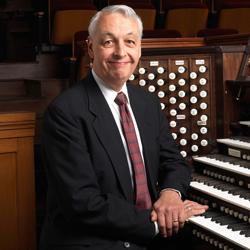
Clay Christiansen retired April 30 at age 69 after nearly 36 years of full-time employment as Mormon Tabernacle Organist for the Church of Jesus Christ of Latter-day Saints in Salt Lake City, Utah, making his final appearance on the Tabernacle Choir’s weekly Sunday morning broadcast Music & The Spoken Word Easter Sunday in the Conference Center on Temple Square, following which he played for his 72nd and final General Conference of the LDS Church. He continues to accept performance engagements and to play occasional noon recitals at the Tabernacle.
Christiansen’s solo career has been marked by appearances throughout the United States, Canada, and England. He has been invited to perform in Vienna, Austria, in October, and on April 28, 2019, will present a program for the Octave of Easter Celebrity Recital at the Basilica of the National Shrine of the Immaculate Conception in Washington, D.C. Appearances with the Tabernacle Choir have also taken him to Europe and Israel.
Christiansen’s solo organ CD Organ of the Mormon Tabernacle was released on the Klavier label. Solo organ performances may also be heard on Now Let Us Rejoice: Organ Hymns for the Sabbath, released on the Mormon Tabernacle Choir label, St. Ambrose Catholic Church Première Recital, The King of Instruments documentary DVD, and solo/duo performances on The Organ at the Mission Inn (Riverside, California).
His organ and vocal compositions are published by MorningStar Music Publishers, Harold Flammer, Jackman Music, and SDG Press. MorningStar organ listings currently include four volumes of hymn preludes, a volume of alternate hymn harmonizations, and three sets of transcriptions.
On April 19 Christiansen was honored for his 27 years of service to the LDS Church’s Musical Instruments Selection Committee on which he took a leading role in designing the digital instruments approved for use in the Church’s meetinghouses worldwide and served as consultant for design and renovation of scores of pipe organs throughout the Church. He was feted by the Tabernacle Choir at a luncheon and receptions on April 26 and 27.
A unique highlight of his Temple Square career included working closely with colleagues John Longhurst and Richard Elliott on the 1997–2002 selection and design of the 130-rank Schoenstein pipe organ for the 21,000-seat Conference Center auditorium.
Christiansen’s undergraduate work was with J. J. Keeler at Brigham Young University. He then became Alexander Schreiner’s last master’s degree candidate at the University of Utah where he eventually also received a Ph.D. in composition under Vladimir Ussaachevsky, Ramiro Cortes, and Bruce Reich. He coached privately over a two-year period with Robert Noehren.
Prior to his 1982 call to the Tabernacle, he served for ten years as organist/choirmaster at the Cathedral Church of St. Mark in Salt Lake City where for four years he was featured in a half-hour weekly broadcast of solo organ music from the Cathedral’s Holtkamp organ.
In addition to performing, composing, and some private teaching, Christiansen now plans to devote more time to his vegetable garden and to his wife of 50 years, Diane, and their 60 grandchildren and two great-grandchildren.

